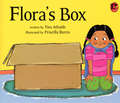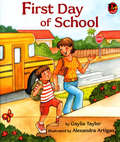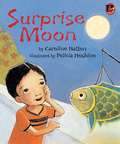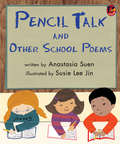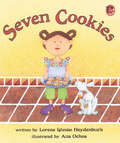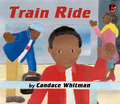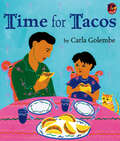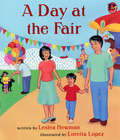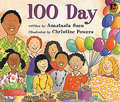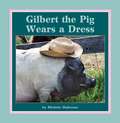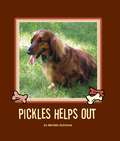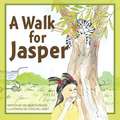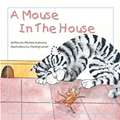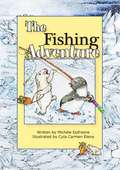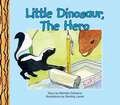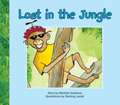- Table View
- List View
Flora's Box
by Priscilla Burris Tina AthaideWith a cardboard box and a little imagination, Flora creates a world of fun. Whether she’s in, under, or next to the box, her ideas have no limits—but the box does!
First Day of School
by Gaylia TaylorFrom saying goodbye to Mom to finding a new friend, a young Latino boy experiences a range of emotions on his very first day of school.
Surprise Moon
by Caroline HattonNick invites his friends to celebrate the Mid-Autumn Moon Festival with him and his family. This festival is set aside to honor children and celebrate their role in the family. Includes brief description of this festival.
Pencil Talk and Other School Poems
by Anastasia SuenSee what fun school can be… when you add some poetry! A simple school day is a lot more fun when you add a little poetry! Follow along for a fresh look at spelling tests, recess, music class and more, in this spirited collection of school day poems.
Ruby's Whistle
by Renee LondnerRuby wants to learn to whistle; her father and mother both try and teach her how but to no avail. She finally learns from an unexpected source.
In The Mountains
by Mary CappelliniIn the Mountains written by Mary Cappellini illustrated by Cheryl Nathan
Seven Cookies
by Lorena Iglesias HeydenburkA Mexican American girl and her grandfather have just finished baking cookies and everyone in the family wants one, including baby brother and the dog. Follow along as the girl shares the cookies one-by-one.
Pran's Week of Adventure
by Tina AthaideWhen the car has to go to the shop, Pran and his mother try a new way to get to school each day. The results are a wacky week full of misadventure!
Train Ride
by Candace Whitman<p>An African American boy experiences the excitement of his very first train ride with his parents. <p>Guided Reading: C ; Interest Level: Grades 1 - 1; Reading Level: Grades 1 - 1 <p>Themes: Vehicles In Motion, Families, Childhood Experiences and Memories, African/African American Interest, Beginning Concepts, People In Motion
Time for Tacos
by Carla Golembe<p>A Mexican American boy and his father spend time together making tacos, and eating them! <p>Guided Reading: C ; Interest Level: Grades 1 - 1; Reading Level: Grades 1 - 1 <p>Themes: Nonfiction, Latino/Hispanic/Mexican Interest, Food, Fathers, Families, Cultural Diversity, Childhood Experiences and Memories, Beginning Concepts, How To
Best Friends
by Tina AthaideBest Friends written by Tina Athaide, photographed by Maria Victoria Torrey.
A Day at the Fair
by Leslea Newman Loretta Lopez<p>After spending an action-packed day at the fair, a Latino boy enjoys one last ride—the ride home! <p>Guided Reading: C <p>Interest Level: Grades 1 - 1 <p>Reading Level: Grades 1 - 1 <p>Themes: Latino/Hispanic/Mexican Interest, Games/Toys, Families, Childhood Experiences and Memories, Realistic Fiction</p>
My Family
by Karen Hjemboe Dorothy SullivanA Cherokee girl learns traditional skills and customs from the members of her family.
100 Day
by Anastasia Suen Christine Powers<p>A class of kindergarten children celebrate the 100th day of school. <p>Guided Reading: C; Interest Level: Grades 1 - 1; Reading Level: Grades 1 - 1; Themes: Comparing/Classifying/Measuring, Counting Money/Everyday Math, Classroom Activities, Multi-ethnic interest, Games/Toys, Education, Cultural Diversity, Childhood Experiences and Memories, Beginning Concepts, Realistic Fiction, Collaboration
Meat Pies
by Celenia Chevere Patricia HerbertAn old woman and a young boy get together and make meat pies.
Gilbert The Pig Wears A Dress
by Michèle Dufresne<P>"The Developing Kit supports students by building a strong reading vocabulary, reading fluency, and comprehension skills. Over the course of a week of lessons, students read a new book each day and a new nonfiction book each week. Each week, they compose a story about something they have learned from reading a nonfiction book and learn about how letters and words work using magnetic letters. Students build a core of words they can read and write. Lessons include guided reading using leveled books, phonics/word work, fluency, comprehension and vocabulary development. Each lesson also includes suggestions for working with second language students."--Website. <P>Word Count: 124
A Walk for Jasper
by Michele Dufresne Sterling LametKatie has a plan for taking Jasper the Cat for a walk. Find out how Jasper feels about the plan.
A Mouse In The House
by Michèle DufresneThere is a mouse in the house that Jasper the Cat wants to catch.
The Fishing Adventure
by Michèle Dufresne"The Early Transitional Kit supports students by building a strong reading vocabulary, reading fluency, and comprehension skills. Over the course of a week of lessons, students read a new book each day and a new nonfiction book each week. Each week, they compose a story about something they have learned from reading a nonfiction book and learn about how letters and words work using magnetic letters. Students build a core of words they can read and write. Lessons include guided reading using leveled books, phonics/word work, fluency, comprehension and vocabulary development. Each lesson also includes suggestions for working with second language students."--Website.
Little Dinosaur, The Hero
by Michèle DufresneLittle Dinosaur saves the day in this fun story about Little Dinosaur and his friends.
